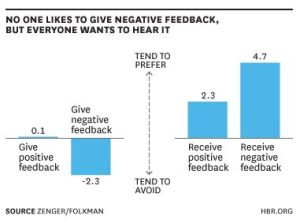It’s now widely agreed that the more autonomy and ownership employees have the more motivated they’ll be. At the same time, there has been little talk about how exactly managers can implement this in practice.
Have you ever seen an employee who was super motivated and confident in their work and then became demotivated after finding out they were going about it wrong? Managers are still responsible for helping reports improve their performance. However, can pointing out mistakes deflate your employee’s motivation high?
It’s essential that new and experienced managers alike learn exactly how to give advice that fuels self-motivation, rather than blowing it out. Here are seven tips to keep in mind:
1. Are you looking at feedback with a growth mindset?
Sometimes the biggest hesitation comes from the feedback giver, rather than the recipient. If you’re hesitant to give an employee feedback, remember that each piece of feedback is the building block for that person’s career development. In fact, a study by psychologist Dr. Carla Jeffries found that a person’s self-esteem and desire to be accepted can be a reason for them failing to give constructive feedback.
 If you feel that giving constructive feedback will damage your relationship with your reports, think again. In a recent report, Gallup highlighted that what millennial employees actually want is more feedback, though only 15% routinely ask for it. The report also found that only 19% receive it regularly. It’s not just praise that they’re looking for either. A study by Zenger/Folkman found that 57% of people would actually prefer to receive constructive over positive feedback. A further 92% agreed that, if given appropriately, constructive feedback is effective at improving performance.
If you feel that giving constructive feedback will damage your relationship with your reports, think again. In a recent report, Gallup highlighted that what millennial employees actually want is more feedback, though only 15% routinely ask for it. The report also found that only 19% receive it regularly. It’s not just praise that they’re looking for either. A study by Zenger/Folkman found that 57% of people would actually prefer to receive constructive over positive feedback. A further 92% agreed that, if given appropriately, constructive feedback is effective at improving performance.
2. Consider the personality of each individual
While there are certain rules to giving feedback correctly, if you get to know each of your teammates well you can more easily adjust your approach to fit their personality. For example, some people like to receive feedback in person so they can talk it through on the spot. Others may prefer time to reflect on their feedback before discussing it with you. If you’re having trouble figuring out the feedback personality of your team, check out this guide on different personality types in the workplace and how to give feedback to each of them.
3. Focus on improvement, not mistakes
For all personality types, it’s important to frame your feedback in a constructive, rather than reproving manner. Rather than dwelling on the past think about the future. Rather than taking it from the perspective of, “This and this didn’t go well,” instead speak in terms of “Next time if we change or add this I believe we can improve performance on this project/task.” This signals to your employee that they shouldn’t stop trying new things, failures are how we learn, improve and succeed. Eliminating fear of failure is one of the most important steps to creating an innovative company culture.
4. Fuel their motivation further
The best way to do this is to help them recognize their strengths and past successes so that they can leverage them to overcome obstacles. Gallup found that employees who use their strengths everyday are 3 times more likely to report having an excellent quality of life, 6 times more likely to be engaged at work, 8% more productive and 15% less likely to quit their jobs.
Whether you’re a feedback sandwich supporter or you prefer straightforward positive or constructive feedback, reminding employees of the tools at their disposal will give them the boost they need to think of creative solutions.
5. Avoid killing projects altogether
Sometimes it may not be a mistake or failure of a project that causes it to be shut down. Sudden shifts in strategy or focus can also lead to realignment in your company and thereby team goals.
In an inspirational TEDTalk, Dan Ariely describes a seriously demotivating situation he encountered at a large tech company in Seattle. A tech team had been tasked to create a new cutting edge product. Suddenly, in the midst of its execution, the team was told that the company decided to go in a different direction and the project was shelved.
The video begins where Ariely discusses the negative impact on engagement and motivation of killing the project and how the team’s morale could have been boosted.
The excitement of a new project can be a great motivator for employees, bringing creativity, excitement and a sense of pride. However, if after putting in the late nights and sacrificing social engagements, their work never sees the light of day, it can quickly bring employees down to a very low level of disengagement.
Even if you have to cancel something your employee worked really hard on, don’t give up on it altogether. Think about other ways this could be used. Maybe it can become an independent project or stretch assignment for the next quarter. Remember companies like Atlassian and Google became famous for giving employees 20% time to work on creative independent ideas. Many of these projects ended up resulting in profit generating new features.
6. Allow for creativity
Not everyone will approach a problem in the same way. Leaving space for trying new things (and most importantly, eliminating fear of failure) is the best way to generate innovation. If you find yourself saying “We always do things this way” or “Let’s not rock the boat” it could be a signal to step back and allow for more risk taking within your team.
7. Learn by doing
Think about the impact of the decision your employee is making. Remember that you can teach someone how to do something but ultimately the best way to learn is by doing. If it’s a small decision that could serve as a learning opportunity, let them make it and be ready to give advice on how to improve next time. Getting the chance to decide and then seeing the results will make them much more likely to come to you and be open for feedback.
